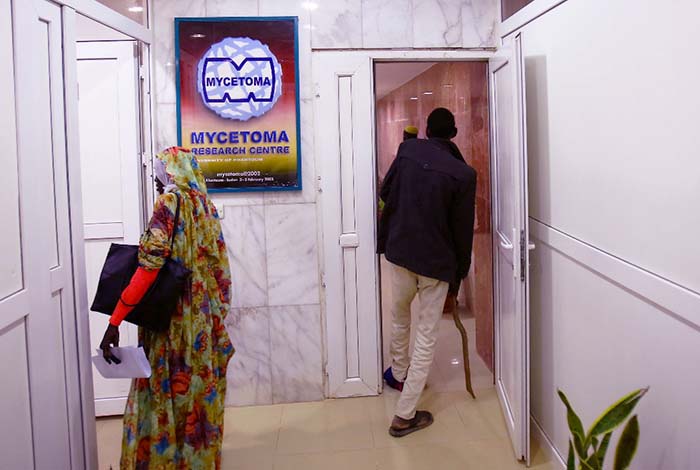Mycetoma Case Reports Repository
The Case Reports Repository will function as a global archive, systematically documenting mycetoma case reports and series from various regions worldwide. It will include clinical data from endemic areas such as Sudan, where mycetoma presents a major public health issue, as well as from emerging cases in non-endemic regions. This resource will be invaluable to clinicians, researchers, educators, students, and public health officials by providing access to a wide range of clinical experiences.
Given that mycetoma often affects underserved populations in rural areas with limited healthcare access, the repository fills an important gap in knowledge. With no established global guidelines for mycetoma management, documenting these cases offers critical insights into the disease varying presentations and outcomes across different regions and settings. This data will assist healthcare professionals in developing more informed, patient-centered treatment approaches.
Ultimately, the repository will serve as a forum for improving the global understanding of mycetoma. By sharing detailed case information, it will support better healthcare outcomes, contribute to the development of treatment protocols, and foster collaboration across the medical and research communities.
The Repository Key Features
The Case Reports Repository will offer a global perspective on mycetoma while maintaining a regional focus. By highlighting cases from endemic areas such as Sudan, Mexico, India, parts of Africa, the Middle East, and South America, the repository will provide essential insights into the epidemiology, common manifestations, and treatment outcomes in regions where healthcare resources may be limited. Additionally, it will include cases from regions where mycetoma is less common or emerging, helping track changes in disease patterns and contributing to a more comprehensive understanding of mycetoma globally. This data will facilitate comparisons across various populations, healthcare systems, and environmental factors, offering a nuanced view of how the disease behaves in different settings.
Each case will be categorised by geographic location, acknowledging the influence of environmental factors like humidity, soil type, and agricultural practices on mycetoma prevalence. For instance, the bacterial and fungal forms of the disease are more common in specific regions, and the repository will help track these variations. This geographic categorisation will enable users to detect regional disease patterns, understand risk factors, and adapt treatment protocols to local conditions, ultimately improving care.
The repository will document a range of case presentations, from common to rare forms of mycetoma, which is vital for enhancing diagnosis and treatment strategies. It will include diverse cases influenced by factors like pathogen type, immune response, and diagnostic timing, providing critical real-world evidence. By showcasing both successful and unsuccessful treatment outcomes, the repository will help clinicians refine their approaches, improving patient care in underserved regions with limited access to specialised healthcare.
The Repository Benefits
The Case Reports Repository will provide essential support for clinicians, especially those in regions lacking access to specialists or established treatment guidelines. It will serve as a practical tool, enabling clinicians to search for similar cases and learn from others experiences, helping them identify effective treatments, surgical interventions, and diagnostic approaches tailored to their patients needs.
For researchers, the repository will be a valuable resource for advancing the understanding of mycetoma. It will help uncover knowledge gaps, evaluate treatment efficacy across diverse populations, and inspire new research into underexplored aspects such as genomic diversity, pathogenesis, and potential therapeutic targets. By analysing real-world data, researchers can identify trends and generate insights that smaller studies might miss.
Public health officials will benefit from the repository’s data on disease patterns, outbreaks, and the effectiveness of public health interventions. This information will support the development of disease prevention programmes, improve early diagnosis and treatment access, and inform health policies. The repository will also help monitor the geographic spread of mycetoma, providing early warnings of emerging hotspots.
The repository will facilitate global collaboration by offering an open-access, navigable platform where clinicians and researchers can contribute case data and share insights. This global exchange will standardise case reporting, enabling better comparisons across different settings and fostering a stronger evidence base for mycetoma diagnosis and treatment.
For educators, the repository will be an invaluable teaching tool, offering medical students, residents, and healthcare providers exposure to diverse clinical scenarios. It will provide detailed case studies that showcase diagnostic challenges, treatment strategies, and patient outcomes, helping train future healthcare professionals to manage mycetoma in both high- and low-resource settings.
The Repository Searchable Database
The repository offers a searchable database that enables users to filter patient case reports based on various criteria, making it easier to access relevant cases for research, clinical comparisons, or educational use. Filtering options include:
- Disease Type: Categorise cases into eumycetoma and actinomycetoma infections.
- Geographic Region: Search cases by country or region, allowing researchers to explore region-specific disease patterns.
- Demographic Characteristics: Classify cases by gender, age, disease duration, and other factors to study disease progression and outcomes.
- Clinical Presentation: Filter reports by patients’ clinical presentations, providing insights to predict appropriate treatment options.
- Diagnostic Method: Search by diagnostic technique (e.g., microbiology, imaging)
- Treatment Modality: Filter by medical, surgical, or combination therapy
- Treatment Outcome: Search outcomes such as cured, ongoing, or fatal cases to evaluate treatment effectiveness and monitor long-term patient responses.
- Complications: Filter by treatment-related complications
- Follow-Up Period: Search by length of post-treatment follow-up




